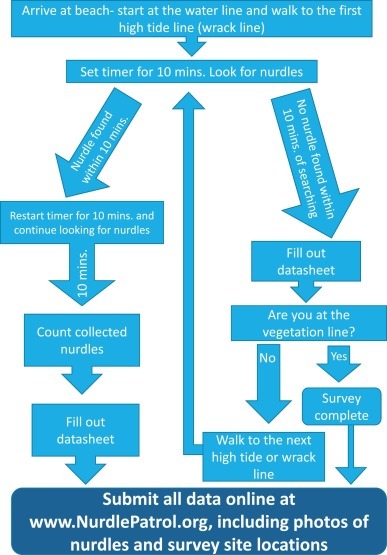Image: Volunteers collecting plastic pellets on a beach in the Gulf of Mexico. CC BY 4.0. Tunnell et al. 2020. https://doi.org/10.1016/j.marpolbul.2019.110794.
This research note summarizes parts of this open access article from the people at Nurdle Patrol and their collaborators:
Tunnell, J.W., Dunning, K.H., Scheef, L.P., and Swanson, K.M. 2020. Measuring plastic pellet (nurdle) abundance on shorelines throughout the Gulf of Mexico using citizen scientists: Establishing a platform for policy-relevant research. Marine Pollution Bulletin, 151:110794. https://doi.org/10.1016/j.marpolbul.2019.110794. CC BY.
The story
In late 2018, the citizen science project known as Nurdle Patrol arose out of an enormous offshore spill of plastic pellets ("nurdles") near Corpus Christi, Texas. As these pellets washed up on local beaches, community members gathered together to start collecting the nurdles and sharing their findings.
Nurdles are lentil-sized pieces of plastic that get melted down and molded to become almost every plastic consumer item you can think of, from bottles to toys to grocery bags. They're a kind of microplastic---pieces of plastic smaller than 5 mm. Petrochemical companies make nurdles from refined oil and gas, and then ship them around the world to other companies that use the nurdles to make plastic products.
Since Nurdle Patrol began, over 2100 volunteers have completed more than 6000 surveys, covering shorelines all throughout the Gulf from Mexico to Florida. At one site in Galveston Bay, TX, volunteers counted more than 30,000 nurdles in 10 minutes. Unsurprisingly, the highest nurdle counts come from sites in a region that hosts the majority of nurdle manufacturing facilities in the US.
How to survey a beach for nurdles
Jace Tunnell, leader of Nurdle Patrol and Director of the Mission-Aransas National Estuarine Research Reserve at the University of Texas Marine Science Institute, teamed up with collaborators to publish their beach survey protocol and guidance for citizen science advocacy in the paper, "Measuring plastic pellet (nurdle) abundance on shorelines throughout the Gulf of Mexico using citizen scientists: Establishing a platform for policy-relevant research."
Quoting the authors:
"This study describes the design, methodology, and evolution of the Nurdle Patrol monitoring project, summarizes the data collected to date, and reviews the utility of the project as it relates to policy decisions and agency action."
Check out the sections below for a summary of the survey protocol.
The basics
You can visit a beach, search for nurdles, collect and count them by hand, then submit your counts with your time and location on the Nurdle Patrol reporting form. Your data will appear on the Nurdle Patrol map, where you'll see the places that other people have found nurdles.
Equipment that will come in handy
- A watch or timer
- A container for collected nurdles: jar, baggie
- A writing pad or app to record your nurdle counts, location, date and time, and any other observations that might be helpful to note
- A camera for taking photographs of the nurdles and survey site
- Gloves
5-minute training video on beach survey protocol
Before doing a survey, you can watch Nurdle Patrol's video on how, when, and where to collect nurdles.
Description and diagram of beach survey protocol
Quoting from Section 2.1, pg. 4 of the paper:
"All surveys start at the water line and move up to the nearest/first high tide line (wrack line; Fig. 3 [see the original paper for this figure]). Once the surveyor has located the beginning point, a ten minute timer is started, and they begin searching for nurdles. If no nurdles are found at the first high tide line after 10 min, the volunteer then moves to the second high tide line, and so on until the highest wrack line or vegetation line is searched. Each tide or wrack line is searched for ten minutes before moving to the next. Volunteers should only move to the next line, if no nurdles were found at the previously searched line. Once a nurdle is found, the timer is restarted for 10 min and nurdle collection begins. If nurdles are found at the first high tide line, then that is the only wrack line that will be surveyed at this site. During the survey, all nurdles are placed directly into a baggie or jar to reduce the likelihood of losing the pellets."
Figure 2, pg. 4 of the paper:

Where to submit your data
Submit your data to Nurdle Patrol via their reporting form. Your counts will then appear on the Nurdle Patrol map!
Are you interested in doing a beach survey for nurdles, or have you done one before? Please share in the comments below!

1 Comments
This is great! Thought if people wanted more visuals and to learn more about wrack zones: https://en.wikipedia.org/wiki/Wrack_zone#:~:text=The%20wrack%20zone%20or%20wrack,is%20deposited%20at%20high%20tide.
Makes me curious if I can find nurdles on beaches here in the Pacific Northwest | Salish Sea...
Reply to this comment...
Log in to comment
Login to comment.